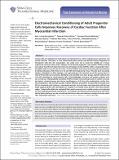| dc.contributor.author | Llucià‐Valldeperas, Aida | en_US |
| dc.contributor.author | Soler‐Botija, Carolina | en_US |
| dc.contributor.author | Gálvez‐Montón, Carolina | en_US |
| dc.contributor.author | Roura, Santiago | en_US |
| dc.contributor.author | Prat‐Vidal, Cristina | en_US |
| dc.contributor.author | Perea‐Gil, Isaac | en_US |
| dc.contributor.author | Sanchez, Benjamin | en_US |
| dc.contributor.author | Bragos, Ramon | en_US |
| dc.contributor.author | Vunjak‐Novakovic, Gordana | en_US |
| dc.contributor.author | Bayes‐Genis, Antoni | en_US |
| dc.date.accessioned | 2017-07-24T18:34:07Z | |
| dc.date.issued | 2016 | en_US |
| dc.identifier.citation | Llucià‐Valldeperas, Aida, Carolina Soler‐Botija, Carolina Gálvez‐Montón, Santiago Roura, Cristina Prat‐Vidal, Isaac Perea‐Gil, Benjamin Sanchez, Ramon Bragos, Gordana Vunjak‐Novakovic, and Antoni Bayes‐Genis. 2016. “Electromechanical Conditioning of Adult Progenitor Cells Improves Recovery of Cardiac Function After Myocardial Infarction.” Stem Cells Translational Medicine 6 (3): 970-981. doi:10.5966/sctm.2016-0079. http://dx.doi.org/10.5966/sctm.2016-0079. | en |
| dc.identifier.issn | | en |
| dc.identifier.uri | http://nrs.harvard.edu/urn-3:HUL.InstRepos:33490798 | |
| dc.description.abstract | Abstract Cardiac cells are subjected to mechanical and electrical forces, which regulate gene expression and cellular function. Therefore, in vitro electromechanical stimuli could benefit further integration of therapeutic cells into the myocardium. Our goals were (a) to study the viability of a tissue‐engineered construct with cardiac adipose tissue‐derived progenitor cells (cardiac ATDPCs) and (b) to examine the effect of electromechanically stimulated cardiac ATDPCs within a myocardial infarction (MI) model in mice for the first time. Cardiac ATDPCs were electromechanically stimulated at 2‐millisecond pulses of 50 mV/cm at 1 Hz and 10% stretching during 7 days. The cells were harvested, labeled, embedded in a fibrin hydrogel, and implanted over the infarcted area of the murine heart. A total of 39 animals were randomly distributed and sacrificed at 21 days: groups of grafts without cells and with stimulated or nonstimulated cells. Echocardiography and gene and protein analyses were also carried out. Physiologically stimulated ATDPCs showed increased expression of cardiac transcription factors, structural genes, and calcium handling genes. At 21 days after implantation, cardiac function (measured as left ventricle ejection fraction between presacrifice and post‐MI) increased up to 12% in stimulated grafts relative to nontreated animals. Vascularization and integration with the host blood supply of grafts with stimulated cells resulted in increased vessel density in the infarct border region. Trained cells within the implanted fibrin patch expressed main cardiac markers and migrated into the underlying ischemic myocardium. To conclude, synchronous electromechanical cell conditioning before delivery may be a preferred alternative when considering strategies for heart repair after myocardial infarction. Stem Cells Translational Medicine 2017;6:970–981 | en |
| dc.language.iso | en_US | en |
| dc.publisher | John Wiley and Sons Inc. | en |
| dc.relation.isversionof | doi:10.5966/sctm.2016-0079 | en |
| dc.relation.hasversion | http://www.ncbi.nlm.nih.gov/pmc/articles/PMC5442794/pdf/ | en |
| dash.license | LAA | en_US |
| dc.subject | Tissue Engineering and Regenerative Medicine | en |
| dc.subject | Biophysical stimulation | en |
| dc.subject | Cardiac adipose tissue‐derived progenitor cells | en |
| dc.subject | Tissue engineering | en |
| dc.subject | Cardiac regeneration | en |
| dc.subject | Electromechanical conditioning | en |
| dc.subject | Myocardial infarction | en |
| dc.title | Electromechanical Conditioning of Adult Progenitor Cells Improves Recovery of Cardiac Function After Myocardial Infarction | en |
| dc.type | Journal Article | en_US |
| dc.description.version | Version of Record | en |
| dc.relation.journal | Stem Cells Translational Medicine | en |
| dash.depositing.author | Sanchez, Benjamin | en_US |
| dc.date.available | 2017-07-24T18:34:07Z | |
| dc.identifier.doi | 10.5966/sctm.2016-0079 | * |
| dash.contributor.affiliated | Sanchez, Benjamin | |


